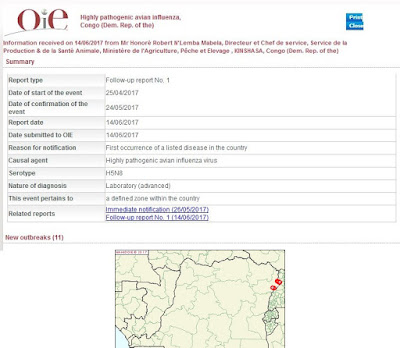#12,545
A little over 2 weeks ago, in OIE Confirms HPAI H5 In DRC, the Democratic Republic of Congo reported their first HPAI H5 bird flu outbreak, although at the time the n-type was unknown.
A few days later, HPAI H5N8 was reported in Zimbabwe, 1400 miles to the south, raising concerns that the virus could spread into South Africa via migratory birds.
Since then, the full subtype from the DRC - HPAI H5N8 clade 2.3.4.4 - has been determined, and more than a dozen additional outbreaks have been reported to the OIE.
Although it only first arrived in Nigeria last November (see OIE Report), caused a major die off of waterfowl on the shores of Lake Victoria in Uganda in January (see Ugandan HPAI H5 Outbreak Confirmed As H5N8), and was confirmed in Cameroon in February, H5N8 has made far greater inroads into Sub-Saharan Africa than H5N1 managed to do over the previous dozen years.
This recently reassorted H5N8 virus appears unusually adept at hitching rides on wild and migratory birds. And unlike its previous incarnations, shows no signs of fading away (see PNAS: The Enigma Of Disappearing HPAI H5 In North American Migratory Waterfowl).
Given the migratory pathways between the Northern and Southern Hemisphere - particularly linking Africa to Europe and Asia - this deep expansion into south and central Africa could influence the future seasonal spread of the virus.
There are also concerns that it could provide new opportunities for the H5N8 virus to reassort with local LPAI viruses. Last winter, the FLI: Updated Risk Assessment On HPAI H5 warned specifically that:
`Generation of reassortants always must be expected when different high and low pathogenic influenza viruses are circulating in one population.'Which appears how this new, reassorted H5N8 virus was generated last summer in either Russia or China, and how HPAI H5N5 and HPAI H5N9 were generated last winter in Europe.
As we've discussed often (see The Challenge Of Avian Flu Surveillance In Sub-Saharan Africa), we probably only hear of a fraction of the outbreaks that occur in Africa, so the 14 H5N8 outbreaks reported so far in the DRC likely under represents the situation.
Not surprisingly, given the rapid spread of HPAI H5, last week DAFF put South Africa On Alert For HPAI H5N8, and warned all poultry interests to beef up their biosecurity.



